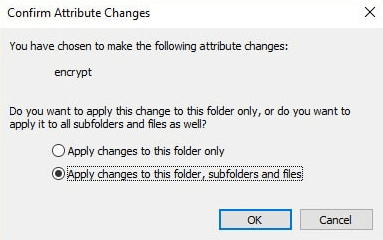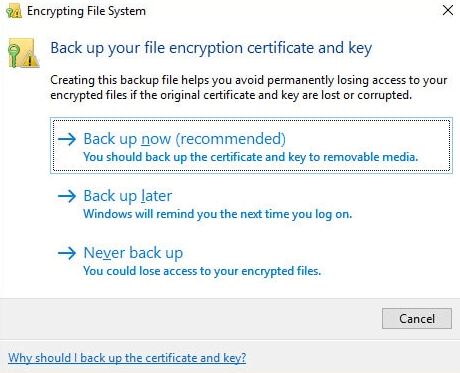We present a simple guide on how to encrypt a file or a folder in Windows. We have also mentioned many encryption programs which you can use to encrypt or protect your file and folder with password.

Then this guide is for you.
You can encrypt your folders and files with the built-in Windows 10 tools.
But, if you have already tried it and looking for some programs to create encrypted & secure files we have also prepared a list for you which will save you a lot of time if you were to research them all.
Table of Contents
What Do You Need To Know About Encryption?
Before starting,
These are the things which you should know about encryption, before creating password protected files or folders.
- Encrypted files are never 100% secure
- Some forms of encryption are hard to break but not impossible
- Malware On Your Computer Could Be Used To Install Keyloggers To Steal Passwords.
- If encrypting files using EFS, a copy of the encrypted file is stored in its temporary memory by computer so the risk is there for unauthorized access of files.
- Consider a paid solution or expert if your data is important (contains sensitive information) and valuable.
- Always Store a backup of unencrypted Files
- A file encrypted with EFS will lose its encryption if moving it to FAT32 or exFAT hard drive & also if transmitting using network or e-mail.
How To Encrypt A File And Folder In Windows 10 With Password
How To Encrypt File And Folders On Windows Using BitLocker
If you decide to encrypt using BitLocker then this is what you need to know before learning about how to make a password-protected file or a folder.
By using Bitlocker your entire volume gets encrypted and no matter who’s logged in, to decrypt or use the drive you would have to enter a password or use a USB drive to unlock it. It can also be used for Full disk encryption.
Bitlocker is available on Windows 10 (Pro, Enterprise, and Education editions), Windows 8 & 8.1 (Pro and Enterprise editions), Windows 7 (Enterprise and Ultimate edition), Windows Vista (Enterprise and Ultimate edition) & Windows Server 2008 & later.
Here’s how to encrypt using BitLocker,
Steps:
- Open Control Panel
- Click on System and Security
- Click on BitLocker Drive Encryption
- Now, click on Turn on BitLocker under BitLocker Drive Encryption
- Click OK And Then Apply
- Plug a USB drive into your PC or select Enter a password. If you select USB drive option then your USB will be set as the trigger to unlock the drive. Otherwise, you can select a password option which we are going to use.
- Type the password you want to set, and click on Next.
- Now just in case if you forget your password, we will set a backup. So now choose, how to save a recovery key to regain access to your drive in case you forget your password.
- Click Next
- Choose an encryption option “Encrypt used disk space only” which is faster or “Encrypt entire drive” which is slower).
- Click Next.
- Now select from two more encryption option, “New Encryption Mode which is best for fixed drives or “Compatible Mode” which is best for removable devices like USB.
- Click Next
- Finally, run the BitLocker system check, which will make sure that the encryption key and recovery work. Then click Continue.
How To Turn Off Bitlocker?
- Right-click on the encrypted drive
- Select Manage Bitlocker
- Now select which encrypted partition or drive you want to disable or suspend the Bitlocker for.
- Then follow the Wizzard.
How To Encrypt Files & Folders On Windows Using EFS – Encrypting File System
Windows comes with this built-in tool. It encrypts files and folders on NTFS drives.
The way to access a drive if encrypted using EFS is through the key.
If you don’t want to encrypt your entire drive in your operating system but rather individual files & directories then this what you should use to secure your files and folders.
Windows creates the encryption key and is saved locally which can be used for decryption. The encrypted files are available only to the user who encrypted it. You can also use EFS for full disk encryption.
Here’s how to encrypt your directory and files using EFS and how to backup your encryption keys used in data encryption and decryption,
Steps:
- Open Windows Explorer, Right-click on the file or the folder you want to encrypt
- In the context menu, select Properties
- Click on the “Advanced” button
- In Advanced Attributes Dialogue box, check “Encrypt contents to secure data”

- Click OK And Then Apply
- If encrypting folder then, in Confirm Attribute Change dialogue box, select the option that fits your needs.

- Click the Back up your file encryption key pop up message. If you can no longer see it, then you can find it in the notification area in Windows.
- Click On the Back up now (recommended) button

- Click Next
- Click next, to create a certificate for you

- Select the default file format to export and then click next

- Now click and check the password box and set your password to encrypt file or folder.

- Navigate where you want to save the certificate and the key and click on save. A “.pfx” file will be created. Always this file saved where you can access it in future.
- Finally, click on Next, Finish and then OK.
Tools To Encrypt Folders & Files With Password
We have tried all these software’s personally just to check if they are worth it. After spending a lot of time trying to find free software over the internet, here are some of the software’s which we think are worth a try.
These are some tools which you can download & use for free if you want to encrypt using the software.
Veracrypt
Veracrypt is free to download encryption & decryption software for Windows, OS X and Linux operating system. It uses AES to encrypt folders and files.
It can also create a virtual encrypted disk in the file and in addition to that, you can also use a pre-boot authentication to the partition or even encrypt the entire storage device which is awesome. You can also password protect those files.
7-Zip
7-Zip is a great and one of the well-known software that can compress a file into a container called “Archive“.
It is available for Windows (Official Version), OS X (Unofficial Version) and Linux (Unofficial Version).
It can encrypt an entire volume into an encrypted volume, which will only have the key which you will own. In addition to that, it uses 256-bit AES encryption. By using 7-Zip you can also password protect your individual files.
Another interesting feature it has is that the single file can be encrypted with a password and can make an executable file that will self-decrypt once it reaches the correct recipient and prevent any unauthorized access.
AESCrypt
AESCrypt uses 256-bit encryption algorithm. However, once a file has been encrypted using this software then that file is completely useless unless the password is used.
So in other words, you don’t have to worry about any person trying to read your sensitive information by unauthorized access.
It is available for Windows, Linux & OS X operating system.
You can download and use this program for free to encrypt your files and folders with a password and it is open-source software.
Winrar
Chances are you have probably heard the name of this software. Winrar is a program that can compress your files & folders and protect them with a password.
Once the file or a folder is encrypted with a password using Winrar then after that it can only be decrypted using the password.
It is useful if you are planning to send the data over the Email or any other digital platform.
It is free to use and moreover, the good thing about this is that it also reduces the file size when it is compressed at last, compared to the original size. You would have to decrypt the encrypted archive to use that file.
AxCrypt
AxCrypt is by far one of the best encryption software’s out there. It uses 128 or 256 bit AES encryption.
Not only that but it also automatically secures your files in cloud storage services including Google Drive, Dropbox and many more.
This is robust file encryption and decryption software which allows you to do much more than namely just encrypting files and decrypting files.
Conclusion
To summarize, before even trying to encrypt files or decrypt anything, either with Windows or with software, you should always keep a backup of the unencrypted version.
Also, you should consider what type of encryption do you want, how convenient it is, its portability and then choose accordingly.